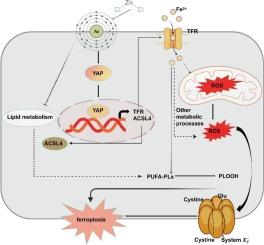锌通过 YAP-TFR/ROS 信号通路减轻砷暴露鲤鱼肾毒性的新见解
IF 4.2
1区 农林科学
Q2 BIOCHEMISTRY & MOLECULAR BIOLOGY
引用次数: 0
摘要
砷或其化合物造成的环境污染称为砷污染。砷污染主要来自人们对砷化合物的开采和冶炼。此外,砷化合物的广泛使用和含砷杀虫剂的生产、用于灌溉农场的富含砷的水或燃煤造成的食物中砷含量过高都是砷污染的来源。砷污染对全球公众健康构成重大威胁。据报道,接触砷会导致严重的肾损伤。然而,其潜在机制尚待明确。本研究采用体内和体外砷暴露模型,探讨砷诱导肾损伤的机制,尤其是铁蛋白沉积的作用及其调控机制,然后评估补锌对肾脏的抗污染作用。结果表明,砷能明显诱导铁变态反应,其特点是上调肾脏和 CIK 细胞中 YAP 和 TFR 的表达,进而增加 Fe2+ 和 ROS 的水平、脂质过氧化和铁代谢。显微镜观察发现线粒体缩小,膜密度增加。此外,分子对接和抑制剂实验进一步证实,砷通过激活 YAP 和 TFR 参与了铁突变过程。这些结果澄清了砷对鲤鱼肾脏的有害影响及其机制,并强调了 YAP-TFR 通路、ROS 和铁突变之间的关键相互作用。重要的是,本研究发现锌可通过抑制 YAP 活化和脂质过氧化来减少砷激活的 YAP-TFR 通路引起的铁突变。本文章由计算机程序翻译,如有差异,请以英文原文为准。

New insights into zinc alleviating renal toxicity of arsenic-exposed carp (Cyprinus carpio) through YAP-TFR/ROS signaling pathway
Environmental pollution caused by arsenic or its compounds is called arsenic pollution. Arsenic pollution mainly comes from people mining and smelting arsenic compounds. In addition, arsenic compounds' widespread use and production of arsenic-containing pesticides, arsenic-rich water used to irrigate farms, or high arsenic levels in foods caused by coal burning are all sources of arsenic contamination. Arsenic contamination poses a significant threat to global public health. It is reported that exposure to arsenic can induce severe renal injury. However, the underlying mechanism needs to be clarified. In this study, the arsenic exposure model in vivo and in vitro was used to explore the mechanism of arsenic-induced renal injury, especially the role of ferroptosis and its regulatory mechanism, and then to evaluate its anti-pollution effect by supplementing zinc. The results showed that arsenic significantly induced ferroptosis, characterized by up-regulating the expression of YAP and TFR in kidney and CIK cells and then increasing the levels of Fe2+ and ROS, lipid peroxidation, and iron metabolism. Microscopic observation revealed the shrinkage of mitochondria and the increase in membrane density. In addition, molecular docking and inhibitor experiments further confirmed that arsenic is involved in the process of ferroptosis by activating YAP and TFR. These results clarify the harmful effects of arsenic on carp kidneys and its mechanism and highlight the critical interactions between the YAP-TFR pathway, ROS, and ferroptosis. Importantly, this study found that zinc can reduce ferroptosis caused by the arsenic-activated YAP-TFR pathway by inhibiting YAP activation and lipid peroxidation.
求助全文
通过发布文献求助,成功后即可免费获取论文全文。
去求助
来源期刊
CiteScore
7.00
自引率
8.50%
发文量
238
审稿时长
4.2 months
期刊介绍:
Pesticide Biochemistry and Physiology publishes original scientific articles pertaining to the mode of action of plant protection agents such as insecticides, fungicides, herbicides, and similar compounds, including nonlethal pest control agents, biosynthesis of pheromones, hormones, and plant resistance agents. Manuscripts may include a biochemical, physiological, or molecular study for an understanding of comparative toxicology or selective toxicity of both target and nontarget organisms. Particular interest will be given to studies on the molecular biology of pest control, toxicology, and pesticide resistance.
Research Areas Emphasized Include the Biochemistry and Physiology of:
• Comparative toxicity
• Mode of action
• Pathophysiology
• Plant growth regulators
• Resistance
• Other effects of pesticides on both parasites and hosts.

 求助内容:
求助内容: 应助结果提醒方式:
应助结果提醒方式:


